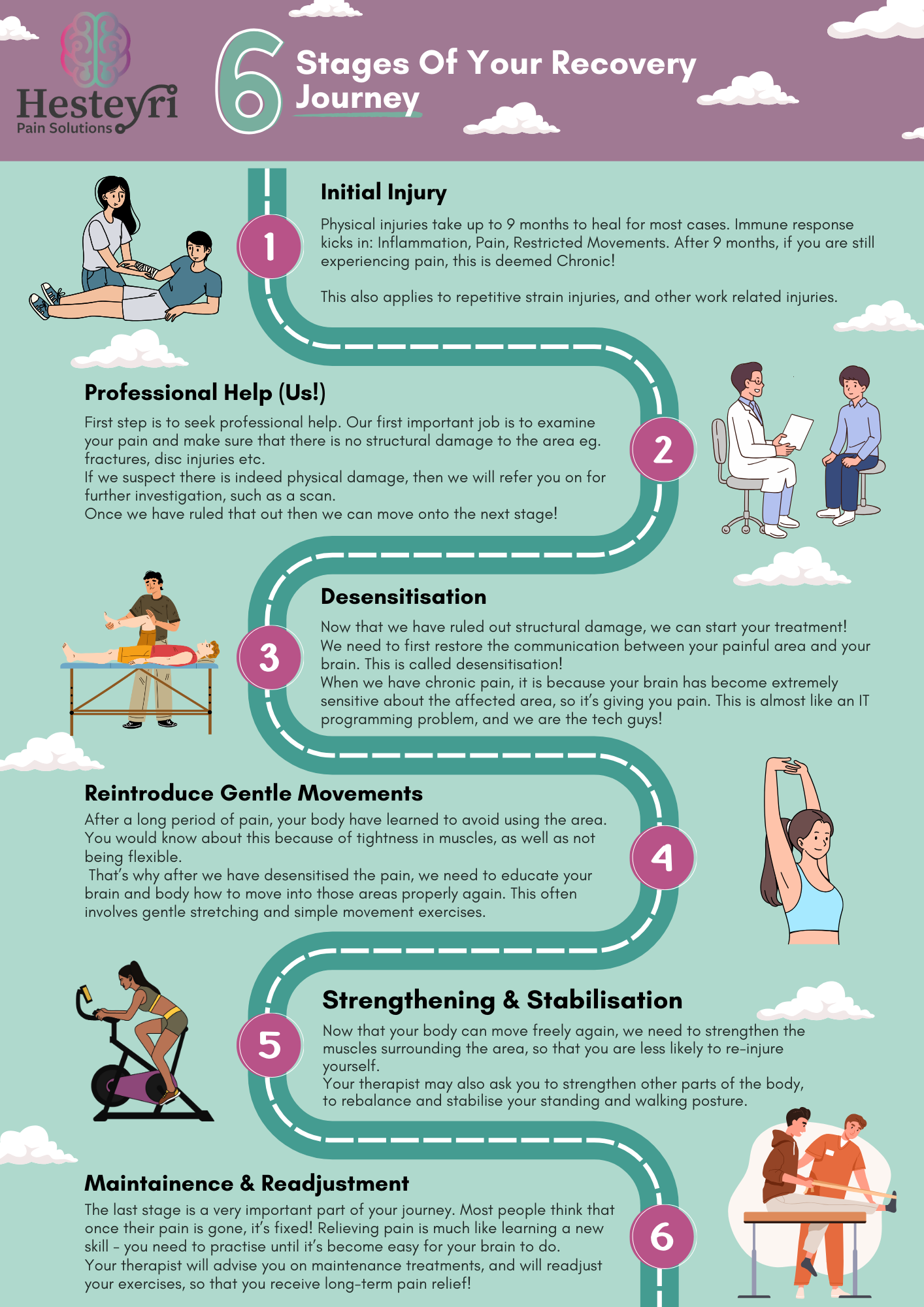
How Do We Help with Chronic Pain
How Do We Help With Your Chronic Pain
Here at Hesteyri Pain Solutions, we approach pain differently to most other therapies. We don't just look at how your body is moving and functioning, we largely look at what your brain is doing in terms of the pain and muscle activation. This is a more holistic approach!
Here's a infographic outlining your treatment process:

Here is the step by step process:
1. Addresses the Root Cause of Pain:
Chronic pain often stems from compensation patterns and dysfunctional proprioception. These can be caused by past injuries, poor movement posture, or repetitive strain.
It is important that we must first identify any structural damage, if there is any. This ensures that the type of treatment we provide to you is specifically targeted to your problem. We do this by different physical and neurological examination.
Once we have ruled out any structural damage, we start by first identifying where the nervous system is not working correctly in relation to your affected area.
Then we identify any psychological and emotional association to the pain. When we experience long-term pain, our brain attaches emotions to it, such as worries and fears. These emotions fuels and maintain the connection for pain, and increases the intensity of it.
We then start correcting those faulty signals from your body, addressing the underlying cause rather than just treating the symptoms.
We will also address any worries and fears of the pain you might have, using a form of eye movement therapy, similar to EMDR (Eye Movement Desensitisation and Reprocessing)
By restoring proprioceptive feedback, improving the coordination between muscles and joints, ensuring that muscles fire correctly to support the spine, as well as helping you process any negative emotions related to your pain, we can reduce stress on the body and alleviate pain.
2. Reduces Compensation Patterns:
After an injury or due to habitual poor movement patterns, certain muscles may overwork while others underperform. It is important that we address these imbalance in the body, as they may lead to secondary issues and pain soon after.
We first identify these compensations and movement patterns through gait analysis and physical examinations.
We then explain to you about the results of the screening, and discuss with you the long-term effects of these compensation patterns in your body.
Once these compensational dysfunctions are identified, we eliminate these compensations by improving communications between your brain and your body, allowing the body to return to its natural, efficient movement patterns.
This reduction in compensatory strain can help prevent further chronic pain, as well as reducing your risk of injuries through weight imbalance in your movement.
3. Restores Muscle Function and Strength:
In chronic pain cases, certain muscles may be underactive due to improper signals from the nervous system.
This creates muscle mass and strength imbalances that may lead to some muscle groups being overused, and some underused. This further creates an increase in muscle mass (hypertrophy) in one area, and a decrease (atrophy) in another. Ultimately leading to higher risk of injuries and chronic pain.
Whilst being pain free is a milestone, it is not the final goal in terms of recovery. Your body requires specific strengthening to ensure that the affected areas are less likely to be re-injured.
By resetting these signals, P-DTR restores normal muscle function, leading to improved strength and stability in the affected and surrounding areas.
4. Provides Long-Lasting Relief:
Many traditional therapies provide temporary pain relief, but because P-DTR corrects the underlying neurological dysfunction, we can achieve results in more long-term improvements. Patients often report that pain relief lasts longer with fewer flare-ups.
It is paramount that we re-examine the joint and muscles in question periodically, to ensure that they have not been re-sensitised. This typically means an assessment and targeted treatment every 4 to 6 weeks.
5. Relieves Pain Without Medication:
The techniques we use are a non-invasive, drug-free approach to pain relief.
It can be especially useful for individuals seeking alternatives to medications or those who haven’t found relief through conventional treatments like physiotherapy or chiropractic care.
In most cases, our clients reduce or cease pain medications during or after their treatment plan.
